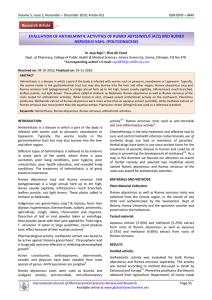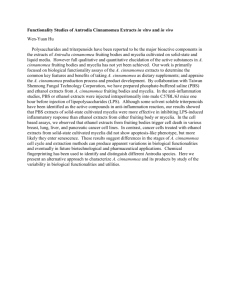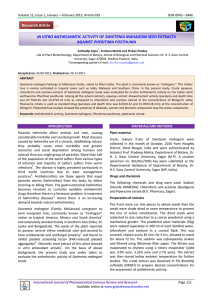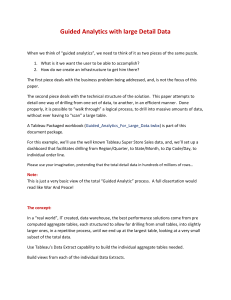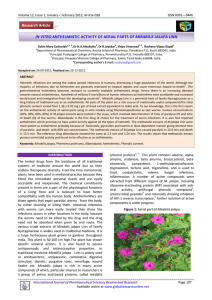Document 13308656
advertisement
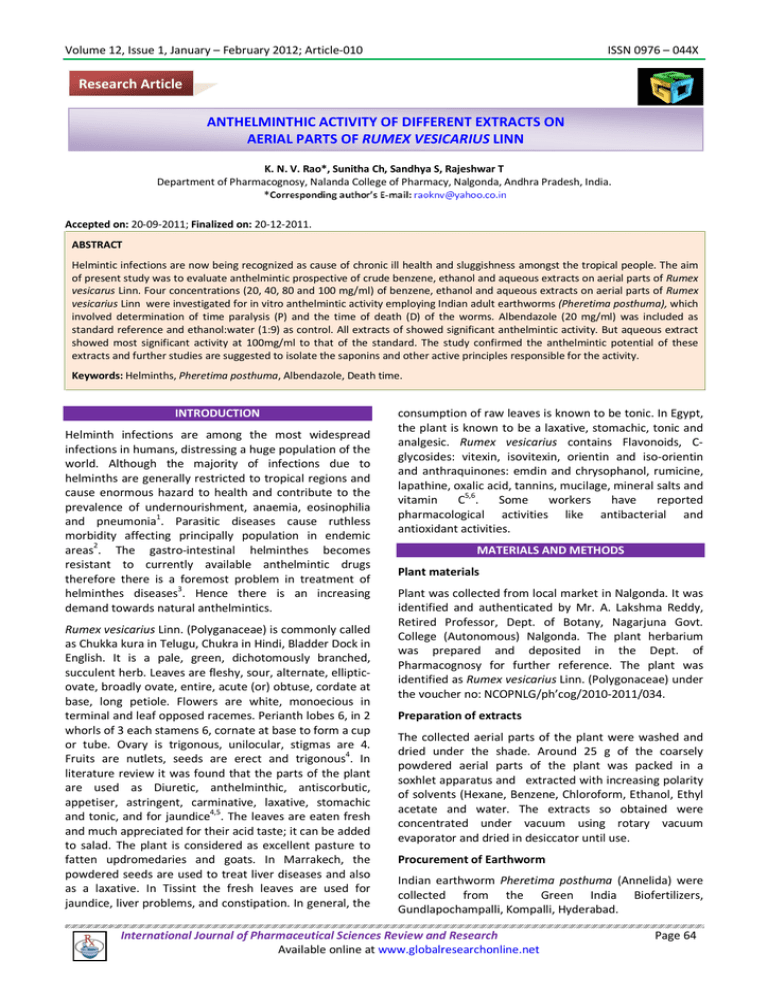
Volume 12, Issue 1, January – February 2012; Article-010 ISSN 0976 – 044X Research Article ANTHELMINTHIC ACTIVITY OF DIFFERENT EXTRACTS ON AERIAL PARTS OF RUMEX VESICARIUS LINN K. N. V. Rao*, Sunitha Ch, Sandhya S, Rajeshwar T Department of Pharmacognosy, Nalanda College of Pharmacy, Nalgonda, Andhra Pradesh, India. Accepted on: 20-09-2011; Finalized on: 20-12-2011. ABSTRACT Helmintic infections are now being recognized as cause of chronic ill health and sluggishness amongst the tropical people. The aim of present study was to evaluate anthelmintic prospective of crude benzene, ethanol and aqueous extracts on aerial parts of Rumex vesicarus Linn. Four concentrations (20, 40, 80 and 100 mg/ml) of benzene, ethanol and aqueous extracts on aerial parts of Rumex vesicarius Linn were investigated for in vitro anthelmintic activity employing Indian adult earthworms (Pheretima posthuma), which involved determination of time paralysis (P) and the time of death (D) of the worms. Albendazole (20 mg/ml) was included as standard reference and ethanol:water (1:9) as control. All extracts of showed significant anthelmintic activity. But aqueous extract showed most significant activity at 100mg/ml to that of the standard. The study confirmed the anthelmintic potential of these extracts and further studies are suggested to isolate the saponins and other active principles responsible for the activity. Keywords: Helminths, Pheretima posthuma, Albendazole, Death time. INTRODUCTION Helminth infections are among the most widespread infections in humans, distressing a huge population of the world. Although the majority of infections due to helminths are generally restricted to tropical regions and cause enormous hazard to health and contribute to the prevalence of undernourishment, anaemia, eosinophilia and pneumonia1. Parasitic diseases cause ruthless morbidity affecting principally population in endemic areas2. The gastro-intestinal helminthes becomes resistant to currently available anthelmintic drugs therefore there is a foremost problem in treatment of helminthes diseases3. Hence there is an increasing demand towards natural anthelmintics. Rumex vesicarius Linn. (Polyganaceae) is commonly called as Chukka kura in Telugu, Chukra in Hindi, Bladder Dock in English. It is a pale, green, dichotomously branched, succulent herb. Leaves are fleshy, sour, alternate, ellipticovate, broadly ovate, entire, acute (or) obtuse, cordate at base, long petiole. Flowers are white, monoecious in terminal and leaf opposed racemes. Perianth lobes 6, in 2 whorls of 3 each stamens 6, cornate at base to form a cup or tube. Ovary is trigonous, unilocular, stigmas are 4. Fruits are nutlets, seeds are erect and trigonous4. In literature review it was found that the parts of the plant are used as Diuretic, anthelminthic, antiscorbutic, appetiser, astringent, carminative, laxative, stomachic 4,5 and tonic, and for jaundice . The leaves are eaten fresh and much appreciated for their acid taste; it can be added to salad. The plant is considered as excellent pasture to fatten updromedaries and goats. In Marrakech, the powdered seeds are used to treat liver diseases and also as a laxative. In Tissint the fresh leaves are used for jaundice, liver problems, and constipation. In general, the consumption of raw leaves is known to be tonic. In Egypt, the plant is known to be a laxative, stomachic, tonic and analgesic. Rumex vesicarius contains Flavonoids, Cglycosides: vitexin, isovitexin, orientin and iso-orientin and anthraquinones: emdin and chrysophanol, rumicine, lapathine, oxalic acid, tannins, mucilage, mineral salts and vitamin C5,6. Some workers have reported pharmacological activities like antibacterial and antioxidant activities. MATERIALS AND METHODS Plant materials Plant was collected from local market in Nalgonda. It was identified and authenticated by Mr. A. Lakshma Reddy, Retired Professor, Dept. of Botany, Nagarjuna Govt. College (Autonomous) Nalgonda. The plant herbarium was prepared and deposited in the Dept. of Pharmacognosy for further reference. The plant was identified as Rumex vesicarius Linn. (Polygonaceae) under the voucher no: NCOPNLG/ph’cog/2010-2011/034. Preparation of extracts The collected aerial parts of the plant were washed and dried under the shade. Around 25 g of the coarsely powdered aerial parts of the plant was packed in a soxhlet apparatus and extracted with increasing polarity of solvents (Hexane, Benzene, Chloroform, Ethanol, Ethyl acetate and water. The extracts so obtained were concentrated under vacuum using rotary vacuum evaporator and dried in desiccator until use. Procurement of Earthworm Indian earthworm Pheretima posthuma (Annelida) were collected from the Green India Biofertilizers, Gundlapochampalli, Kompalli, Hyderabad. International Journal of Pharmaceutical Sciences Review and Research Available online at www.globalresearchonline.net Page 64 Volume 12, Issue 1, January – February 2012; Article-010 The assay was performed on adult Indian earthworm Pheretima posthuma, due to its anatomical and physiological resemblance with the intestinal roundworm 7,8 parasites of human beings. Preparation of test sample Samples for in-vitro study were prepared by dissolving and suspending 2gms of each crude benzene, ethanolic and aqueous extracts in 10 ml of ethanol:water (1:9) to obtain a stock solution of 100 mg/ml. From this stock solution, different working dilutions were prepared to get concentration range of 20, 40 and 80 mg/ml Procedure9,10 The anthelmintic assay was carried as per the method of Ajayieoba E. O. et al., with minor modifications. The earthworms of 4-6 cm in length and 0.3-0.4 cm in width were used for all experimental protocol. Fourteen groups of approximately equal size Indian earthworms consisting of three worms in each group were released into 10 ml of desired formulation. Each group was treated with the following: Group 1: Control (Ethanol:Water(1:9)) Group 2: Standard Albendazole drug (20mg/ml) ISSN 0976 – 044X Group 3, 4, 5, 6: Benzene extracts of aerial parts of Rumex vesicarius Linn at the dose of 20, 40, 80 and 100 mg/ml respectively. Group 7, 8, 9, 10: Ethanol extracts of aerial parts of Rumex vesicarius Linn at the dose of 20, 40, 80 and 100 mg/ml respectively Group 11, 12, 13, 14: Aqueous extract of aerial parts of Rumex vesicarius Linn at the dose of 20, 40, 80 and 100 mg/ml respectively Observations were made as the time taken for paralysis and / or death of individual earthworms. The time of paralysis was noted when worms do not revive even in the normal saline and when no movement of any sort could be observed except when the worms were shaken vigorously. Death was concluded when the worms lost their motility. RESULTS AND DISCUSSION Dose dependent increase in Time of paralysis and death were observed in all extracts (table 1, fig 1 and 2). Aqueous extract showed better activity than Benzene and Ethanol extracts of Rumex vesicarius Linn. The Aqueous extract exhibited significant activity at 100mg/ml for Time of paralysis and Time of death, 9.5±0.51mins and 14.96±0.44mins respectively comparable with standard albendazole 7.00±0.25mins and 13.05±0.23mins. Table 1: Anthelminthic screening of different extracts of Rumex vesicarius Treatment Control Albendazole Benzene extract Ethanol extract Aqueous extract Concentration used in mg/ml 20mg/ml 20mg/ml 40mg/ml 80mg/ml 100mg/ml 20mg/ml 40mg/ml 80mg/ml 100mg/ml 20mg/ml 40mg/ml 80mg/ml 100mg/ml Time taken for Paralysis (mins) 29.6±0.70 7.00±0.25 23.95±0.43 23.00±0.26 22.31±0.38 19.43±0.66 19.23±0.18 18.73±0.40 16.00±0.41 14.16±0.28 13.03±0.23 11.83±0.33 10.16±0.38 9.5±0.51 Figure 1: Effect on time of paralysis of different extracts of Rumex vesicarius Time taken for death (mins) 35.01±0.43 13.05±0.23 32.95±0.28 31.73±0.63 29.66±0.29 27.38±0.62 26.95±0.44 27.20±0.11 24.93±0.17 22.94±0.43 21.91±0.40 18.83±0.37 15.63±0.39 14.96±0.44 Figure 2: Effect on time of death by different extracts of Rumex vesicarius International Journal of Pharmaceutical Sciences Review and Research Available online at www.globalresearchonline.net Page 65 Volume 12, Issue 1, January – February 2012; Article-010 The Anthelminthic activity was carried out and results of Benzene, Ethanol and Aqueous extracts of Rumex vesicarius Linn were recorded. The three extracts of Rumex vesicarius Linn exhibits dose dependent activity for time of paralysis and death. Benzene extract at a dose of 100mg/ml exhibits a time of paralysis and death within 19.43 mins and 27.3 mins, Ethanol extract at a dose of 100mg/ml exhibits a time of paralysis and death within 14.16 mins and 22.9 mins and Aqueous extract at a dose of 100mg/ml exhibits a time of paralysis and death within 9.5mins and 14.9 mins. Whereas the standard Albendazole at a dose of 20mg/ml exhibits a time of paralysis and death within 7.00mins and 13.05mins. By these results aqueous extract exhibits better activity than the Benzene and ethanol extract of Rumex vesicarius Linn. Aqueous extract shows significant activity with that of the standard albendazole. This may be due to the presence of saponins in the extract. These saponins are the tritepenoids they may inhibit the food intake causes paralysis and death of the organism11-13. CONCLUSION Anthelminthic activity for three extracts has shown positive result in a dose dependent manner. Aqueous extract of Rumex vesicarius Linn at 100mg/ml exhibited a significant anthelminthic activity with that of standard. Saponins may be responsible for this activity. REFERENCES ISSN 0976 – 044X 3. Sondhi SM., Shahu R., Magan Archana. Indian Drugs 31(7): 1994; 317-320. 4. Madhavashetty K Dr,Shivaji K, Tulasirao K, Flowering plants of chittor district, Andhra pradesh, India;298. 5. Nardkarnis K.M. Dr, Indian materia medica, vol:1:10801081. 6. Pullaiah T, Ali Moulali D, Flora of Andhra Pradesh (India) Vol:2:910-911. 7. Ravindra G mali and anitha a Mehta “a review on anthelminthic plants”, Natural product radiance, 7(5),2008,466-475. 8. Satish B. Kosalge, Ravindra A. Fursule ,” Investigation of In Vitro Anthelmintic Activity Of Thespesia Lampas (Cav.),” Asian Journal of Pharmaceutical and Clinical Research, Volume 2, Issue 2, April- June, 2009. 9. Gaurav Dwivedi,Arshad Ali Noorani, Deependra Rawal, Hitesh Patidar,” Anthelmintic Activity Of Emblica Officinalis Fruit Extract,” International journal of pharma research and development,3(1),2011,50-52 10. Jaya Raju.N,Elias Ali Yesuf,” Evaluation of Anthelmintic Activities Of Rumex Abyssinicus Jacq And Rumex Nervosus Vahl. (Polygonaceae)”, International Journal of Pharmaceutical Sciences Review and Research, 5(2),2010,55-57. 11. S. Athanasiadou1-, J. Githiori2 and I. Kyriazakis,” Medicinal plants for helminth parasite control: facts and fiction,” Animal (2007), 1:9, pp 1392–1400. 1. Bundy D A. Immunoepidemiology of intestinal helminthic infection I: The global burden of intestinal nematode disease. Trans Royal Soc Trop Med Hyg 1994; 8: 259-261. 12. Lipi Purwal1, Vivek Shrivastava1, Krishna K Makode1, Umesh K Jain,” Anthelmintic activity of aqueous extracts of some Saponin containing medicinal plants,” Der Pharmacia Lettre, 2010, 2(4): 476-481. 2. Tagbota S, Townson S. Antiparasitic properties of medicinal and other naturally occurring products, Adv Parasitol 50:2001; 199-205. 13. SL Deore, and s.s khadabadi,”invitro anthelmintic studies of chlorophytum borivilianum sant &Fernandez tubers, indian journal of natural products and resources,1(1),2010,53-56. ***************** International Journal of Pharmaceutical Sciences Review and Research Available online at www.globalresearchonline.net Page 66
